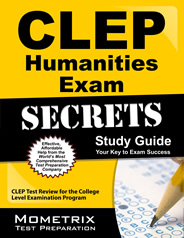CLEP Humanities Exam Study Guide
The Humanities examination tests general learning of writing, craftsmanship, and music and the other performing expressions. It is wide in its scope, with inquiries on all periods from established to contemporary and in various fields: verse, writing, rationality, workmanship, construction modeling, music, move, theater, and film. The examination obliges contender to show their comprehension of the humanities through memory of particular data, perception and use of ideas, and investigation and understanding of different centerpieces.
Syllabus of the CLEP Humanities Exam
Inquiries on the Humanities examination oblige contender to show the capacities recorded beneath, in the rough rates showed. A few inquiries may require more than one of the capacities.
1. Learning of verifiable data (creators, meets expectations, and so forth.) (50 percent of the examination)
2. Acknowledgment of procedures, for example, rhyme plan, medium, and matters of style, and the capacity to distinguish them as qualities of specific essayists, specialists, schools, or periods (30 percent of the examination)
3. Comprehension and understanding of scholarly entries and craftsmanship multiplications that are liable to be new to most hopefuls (20 percent of the examination).
The topic of the Humanities examination is drawn from the accompanying subjects. The rates alongside the points demonstrate the inexact percent-times of exam inquiries on those subjects.
A. Writing - 50%
B. The Arts - 50%
The exam inquiries, drawn from the whole history of workmanship and society, are reasonably equitably partitioned among the accompanying periods: Classical, Medieval and Renaissance, seventeenth and eighteenth hundreds of years, nineteenth century, and twentieth century. No less than 5-10 percent of the inquiries draw on different societies, for example, African, Asian, and Latin American. A portion of the inquiries cross orders and/or ordered periods, and a significant number test information of wording, classification, and style.
Format of the CLEP Humanities Exam
Since the exam is exceptionally wide in its scope, it is impossible that any one individual will be very much educated about all the fields it covers. The exam contains roughly 140 inquiries to be replied in 90 minutes. Some of these are pretest inquiries that won't be scored. At whatever time applicants spend on instructional exercises or giving individual data is notwithstanding the genuine testing time. For applicants with acceptable scores on the Humanities examination, schools may concede up to six semester hours (or the proportionate) of credit toward satisfaction of an appropriation necessity. Some may allow credit for a specific course that matches the exam in substance.
This examination utilizes the sequential assignments b.c.e. (prior to the BC) and c.e. (BC). These names relate to b.c. (before Christ) and a.d. (in the year of the Lord), which are utilized as a part of a few course books.
Study Guide And Test Preparation For CLEP Humanities Exam
A Complete CLEP Humanities Exam Study Guide that includes sample questions, test tips and a complete study plan prepared by a team of expert and dedicated researchers. Cost-effective and qualified exam help from a committed exam preparation company.
